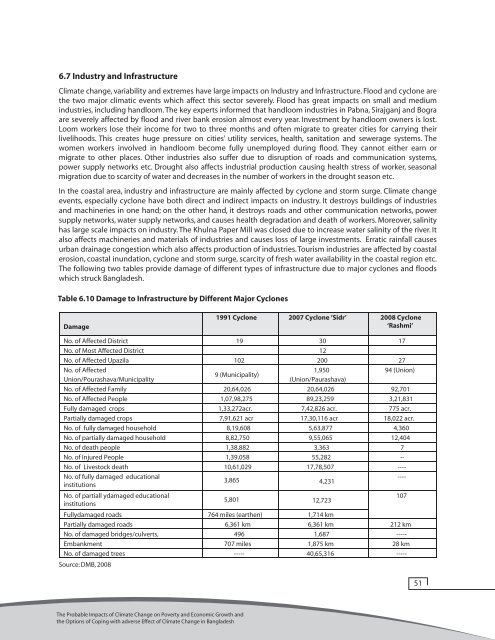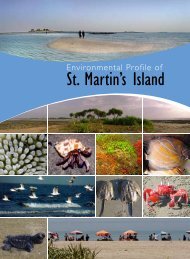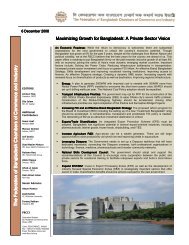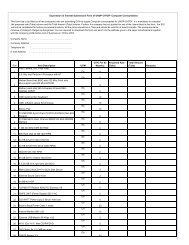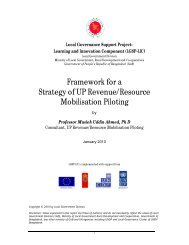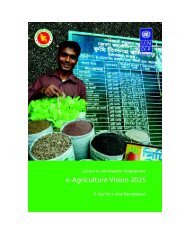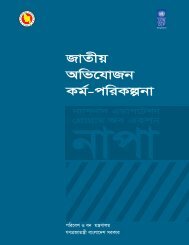The probable impacts of climate change on poverty - UNDP
The probable impacts of climate change on poverty - UNDP
The probable impacts of climate change on poverty - UNDP
You also want an ePaper? Increase the reach of your titles
YUMPU automatically turns print PDFs into web optimized ePapers that Google loves.
6.7 Industry and Infrastructure<br />
Climate <str<strong>on</strong>g>change</str<strong>on</strong>g>, variability and extremes have large <str<strong>on</strong>g>impacts</str<strong>on</strong>g> <strong>on</strong> Industry and Infrastructure. Flood and cycl<strong>on</strong>e are<br />
the two major climatic events which affect this sector severely. Flood has great <str<strong>on</strong>g>impacts</str<strong>on</strong>g> <strong>on</strong> small and medium<br />
industries, including handloom. <str<strong>on</strong>g>The</str<strong>on</strong>g> key experts informed that handloom industries in Pabna, Sirajganj and Bogra<br />
are severely affected by flood and river bank erosi<strong>on</strong> almost every year. Investment by handloom owners is lost.<br />
Loom workers lose their income for two to three m<strong>on</strong>ths and <str<strong>on</strong>g>of</str<strong>on</strong>g>ten migrate to greater cities for carrying their<br />
livelihoods. This creates huge pressure <strong>on</strong> cities’ utility services, health, sanitati<strong>on</strong> and sewerage systems. <str<strong>on</strong>g>The</str<strong>on</strong>g><br />
women workers involved in handloom become fully unemployed during flood. <str<strong>on</strong>g>The</str<strong>on</strong>g>y cannot either earn or<br />
migrate to other places. Other industries also suffer due to disrupti<strong>on</strong> <str<strong>on</strong>g>of</str<strong>on</strong>g> roads and communicati<strong>on</strong> systems,<br />
power supply networks etc. Drought also affects industrial producti<strong>on</strong> causing health stress <str<strong>on</strong>g>of</str<strong>on</strong>g> worker, seas<strong>on</strong>al<br />
migrati<strong>on</strong> due to scarcity <str<strong>on</strong>g>of</str<strong>on</strong>g> water and decreases in the number <str<strong>on</strong>g>of</str<strong>on</strong>g> workers in the drought seas<strong>on</strong> etc.<br />
In the coastal area, industry and infrastructure are mainly affected by cycl<strong>on</strong>e and storm surge. Climate <str<strong>on</strong>g>change</str<strong>on</strong>g><br />
events, especially cycl<strong>on</strong>e have both direct and indirect <str<strong>on</strong>g>impacts</str<strong>on</strong>g> <strong>on</strong> industry. It destroys buildings <str<strong>on</strong>g>of</str<strong>on</strong>g> industries<br />
and machineries in <strong>on</strong>e hand; <strong>on</strong> the other hand, it destroys roads and other communicati<strong>on</strong> networks, power<br />
supply networks, water supply networks, and causes health degradati<strong>on</strong> and death <str<strong>on</strong>g>of</str<strong>on</strong>g> workers. Moreover, salinity<br />
has large scale <str<strong>on</strong>g>impacts</str<strong>on</strong>g> <strong>on</strong> industry. <str<strong>on</strong>g>The</str<strong>on</strong>g> Khulna Paper Mill was closed due to increase water salinity <str<strong>on</strong>g>of</str<strong>on</strong>g> the river. It<br />
also affects machineries and materials <str<strong>on</strong>g>of</str<strong>on</strong>g> industries and causes loss <str<strong>on</strong>g>of</str<strong>on</strong>g> large investments. Erratic rainfall causes<br />
urban drainage c<strong>on</strong>gesti<strong>on</strong> which also affects producti<strong>on</strong> <str<strong>on</strong>g>of</str<strong>on</strong>g> industries. Tourism industries are affected by coastal<br />
erosi<strong>on</strong>, coastal inundati<strong>on</strong>, cycl<strong>on</strong>e and storm surge, scarcity <str<strong>on</strong>g>of</str<strong>on</strong>g> fresh water availability in the coastal regi<strong>on</strong> etc.<br />
<str<strong>on</strong>g>The</str<strong>on</strong>g> following two tables provide damage <str<strong>on</strong>g>of</str<strong>on</strong>g> different types <str<strong>on</strong>g>of</str<strong>on</strong>g> infrastructure due to major cycl<strong>on</strong>es and floods<br />
which struck Bangladesh.<br />
Table 6.10 Damage to Infrastructure by Different Major Cycl<strong>on</strong>es<br />
Damage<br />
Event<br />
<str<strong>on</strong>g>The</str<strong>on</strong>g> Probable Impacts <str<strong>on</strong>g>of</str<strong>on</strong>g> Climate Change <strong>on</strong> Poverty and Ec<strong>on</strong>omic Growth and<br />
the Opti<strong>on</strong>s <str<strong>on</strong>g>of</str<strong>on</strong>g> Coping with adverse Effect <str<strong>on</strong>g>of</str<strong>on</strong>g> Climate Change in Bangladesh<br />
1991 Cycl<strong>on</strong>e 2007 Cycl<strong>on</strong>e ‘Sidr’ 2008 Cycl<strong>on</strong>e<br />
‘Rashmi’<br />
No. <str<strong>on</strong>g>of</str<strong>on</strong>g> Affected District 19 30 17<br />
No. <str<strong>on</strong>g>of</str<strong>on</strong>g> Most Affected District 12<br />
No. <str<strong>on</strong>g>of</str<strong>on</strong>g> Affected Upazila 102 200 27<br />
No. <str<strong>on</strong>g>of</str<strong>on</strong>g> Affected<br />
Uni<strong>on</strong>/Pourashava/Municipality<br />
9 (Municipality)<br />
1,950<br />
(Uni<strong>on</strong>/Paurashava)<br />
94 (Uni<strong>on</strong>)<br />
No. <str<strong>on</strong>g>of</str<strong>on</strong>g> Affected Family 20,64,026 20,64,026 92,701<br />
No. <str<strong>on</strong>g>of</str<strong>on</strong>g> Affected People 1,07,98,275 89,23,259 3,21,831<br />
Fully damaged crops 1,33,272acr. 7,42,826 acr. 775 acr.<br />
Partially damaged crops 7,91,621 acr 17,30,116 acr 18,022 acr.<br />
No. <str<strong>on</strong>g>of</str<strong>on</strong>g> fully damaged household 8,19,608 5,63,877 4,360<br />
No. <str<strong>on</strong>g>of</str<strong>on</strong>g> partially damaged household 8,82,750 9,55,065 12,404<br />
No. <str<strong>on</strong>g>of</str<strong>on</strong>g> death people 1,38,882 3,363 7<br />
No. <str<strong>on</strong>g>of</str<strong>on</strong>g> Injured People 1,39,058 55,282 --<br />
No. <str<strong>on</strong>g>of</str<strong>on</strong>g> Livestock death 10,61,029<br />
17,78,507 ----<br />
No. <str<strong>on</strong>g>of</str<strong>on</strong>g> fully damaged educati<strong>on</strong>al<br />
instituti<strong>on</strong>s<br />
3,865<br />
4,231<br />
----<br />
No. <str<strong>on</strong>g>of</str<strong>on</strong>g> partiall ydamaged educati<strong>on</strong>al<br />
instituti<strong>on</strong>s<br />
5,801<br />
12,723<br />
Fullydamaged roads 764 miles (earthen) 1,714 km<br />
Partially damaged roads 6,361 km 6,361 km 212 km<br />
No. <str<strong>on</strong>g>of</str<strong>on</strong>g> damaged bridges/culverts, 496 1,687 -----<br />
Embankment 707 miles 1,875 km 28 km<br />
No. <str<strong>on</strong>g>of</str<strong>on</strong>g> damaged trees ----- 40,65,316 -----<br />
Source: DMB, 2008<br />
107<br />
51


